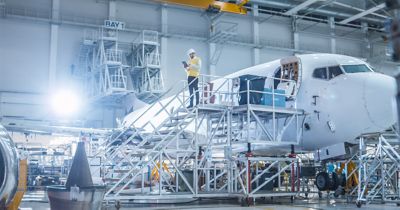-
-
Access Free Student Software
Ansys empowers the next generation of engineers
Students get free access to world-class simulation software.
-
Connect with Ansys Now!
Design your future
Connect with Ansys to explore how simulation can power your next breakthrough.
Countries & Regions
Free Trials
Products & Services
Learn
About
Back
Products & Services
Back
Learn
Ansys empowers the next generation of engineers
Students get free access to world-class simulation software.
Back
About
Design your future
Connect with Ansys to explore how simulation can power your next breakthrough.
Free Trials

A propulsion engineer for a leading space company sits at her desk. She’s part of a global team that is working on designing, developing, and testing the engines and propulsion systems that power the launch vehicle into space. She is evaluating and optimizing the combustion process to generate thrust and ensuring that the vehicle reaches its intended orbit efficiently.
She begins her day at 7 a.m. by logging in to Ansys Minerva simulation process and data management (SPDM) software’s centralized platform. Immediately, she sees notifications about overnight simulation results from another team about the thermal analysis results. Through Minerva software, she can access the latest validated simulation models, ensuring that everyone works from the same verified data sources. The version control system tracks every modification, eliminating the risk of using outdated information that could mean costly rework.
At 11 a.m., a design review meeting brings together teams from three locations. The discussion centers around a potential material change for the nozzle assembly. Using Minerva software, they can instantly trace the decision-making history that led to the current design and assess the impact of the proposed change across all affected systems. This helps to significantly accelerate the decision-making process.
As space organizations push the boundaries of innovation, the role of SPDM becomes increasingly critical. The future of space demands not just powerful simulation tools but robust systems to manage the simulation data and complex workflows that these tools generate.
Minerva software continues to evolve to meet these challenges with workflow optimization, cloud based high-performance computing integrations, and enhanced collaboration tools. These capabilities ensure that space organizations can maintain their competitive edge while meeting the industry’s stringent safety and reliability requirements.

The Value Proposition of SPDM in Space Applications
Knowledge Capture and Reuse
One of the most critical advantages of SPDM in space applications is the ability to capture and reuse institutional knowledge. Space organizations often face challenges with knowledge retention due to long project life cycles and workforce changes. Minerva software ensures that simulation workflows, best practices, and design decisions are documented and readily accessible for current and future projects.
Regulatory Compliance and Traceability
Space program development requires rigorous documentation for certification and safety compliance. SPDM automatically enables the digital thread of all simulation activities, making it straightforward and easy to demonstrate compliance to regulatory authorities.
Enhanced Collaboration and Efficiency
Minerva software can fundamentally transform how engineering teams collaborate and manage simulation data with centralized data management, process automation, enhanced collaboration, and knowledge capture. Eliminating data silos and version control issues, it provides complete traceability of all engineering decisions. Minerva software offers intelligent search and discovery of simulation data and models, resulting in the reduction of time spent searching for information.
Risk Reduction
Launch vehicle development involves significant technical and financial risks. SPDM helps organizations minimize these risks by:
- Ensuring consistent use of validated simulation methods
- Maintaining data integrity throughout the development life cycle
- Enabling rapid impact assessment of design changes
- Enabling virtual testing and reporting before physical prototyping
As the space industry continues to be challenged with high levels of complexity, Minerva software can help stakeholders streamline and develop efficient workflows and processes to ensure mission success. Providing benefits that accelerate innovation while maintaining the highest standards for safety, Minerva software plays a crucial role in space exploration.
To reach the lofty goals of space organizations, engineering teams often turn to SPDM as one of the solutions. Here, we’ll take a closer look at the benefits of Minerva software when paired with VCollab, a service that helps you realize the full benefits of computer-aided engineering (CAE) through rapid results review.
Rapidly Visualize and Interpret Data
Not only do engineers and researchers need to get data quickly, but they need to analyze it rapidly to make informed decisions. To accomplish this, ensuring that the data is visualized in a way that is sharable and easy to understand for those from multidisciplinary backgrounds is essential — especially when dealing with the complicated data needed for space.
Minerva software enables this goal by automating typically tedious processes. For example, one of the key features is the ability to create reports and visualizations by automatically extracting relevant information and simulation decision support via role-based dashboards and reports that contain full traceability about where the information comes from. These features help researchers in the space industry quickly move from data to decisions.
When Minerva software is coupled with VCollab’s visualization tools, the resulting reports are delivered as live 3D models that can be interrogated interactively and shared with heterogenous teams through HTML. Since HTML can be viewed in a browser and is thus easy to share, this widens the number of people who can assist in the analysis process, including contractors and customers.
These 3D models can be analyzed in real time when reviewing data, enabling a much more thorough investigation than with a traditional slide deck or even a video presentation. As such, these models enable functionality that wouldn’t be possible with traditional visualization tools. For instance, a launcher engineer could host a design review meeting and use a live 3D model to show different design iterations via interactive overlays, rotate the design to see different points of interest or concern, view multiphysics data on a single model, and more. In particular, VCollab’s ability to visualize the different types of physics data in a single model is extremely important for gaining a full systemwide interpretation of a design.
By using this functionality to both visualize and interpret critical data, those in the space industry can save a great deal of time in their design and development processes.
Convenient Long-term Data Storage
Long after a project is completed in the space industry, the related data needs to remain safely stored to comply with regulations, such as the long-term archiving and retrieval (LOTAR) standard. However, due to the amount of data generated in the research, design, development, and analysis processes, as well as the speed at which the data is generated, this is a challenging task.
To easily and securely store this data, space companies can turn to Minerva software. Data management is a key benefit of this software, which contains data organization features, such as libraries and search and configuration management tools, like version management. Here, the storage of large simulation models is greatly enhanced through using VCollab’s compressed model files, which maintain all the critical simulation results at a reduced file size.
Beyond storage, these features prove useful in the event that data auditing occurs. For instance, say the launcher design was deployed and performed better than expected. With Minerva software and VCollab, this archived data can be easily pulled, visualized, and used as a reference to enable the next generation of space travel.
SPDM and the Future of Space
To excel in the fast-moving space industry, more and more companies are finding that generic data management tools are not enough. Instead, they need tools like Minerva software and VCollab, which provide functionality well beyond simulation data management and can also handle complex data, improve collaboration, rapidly analyze data, collaboratively reach design decisions, and provide trusted long-term storage.
By using these tools, engineering teams can more effectively organize and use simulation data via dynamic models that contain all the key information needed to make critical decisions. By exchanging weeks of work full of manual, error-prone processes for automated, efficient technologies, SPDM software has the ability to transform the space industry and help us reach new heights.
Explore how simulation revolutionizes the space sector.
The Advantage Blog
The Ansys Advantage blog, featuring contributions from Ansys and other technology experts, keeps you updated on how Ansys simulation is powering innovation that drives human advancement.


